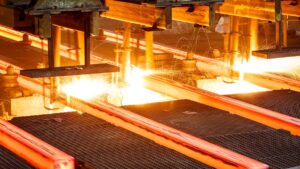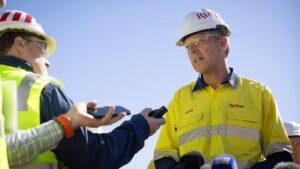Rio Tinto cuts interim dividend by a third as profit falls 43% to … US$5 billion

Rio has slashed its own expectations by a third, while still posting a massive profit. Pic via Getty Images.
- Rio Tinto has cut its interim dividend in a third as profits fell 43% in the first half of 2023
- CEO Jakob Stausholm says Rio’s performance remains strong against the backdrop of a softer global economy and compared to the second half of 2022
- Rio reveals cost blowout on starter DLE lithium project at Rincon
Rio Tinto (ASX:RIO) has cut its ordinary interim dividend by 34% to US$1.77 per share, putting around $4.3bn in the pockets of shareholders as weaker economic conditions and costs saw profits fall.
Rio weathered a 43% cut in profit from US$8.95 billion in H1 2022 to US$5.12bn for the first half of 2023, with revenue sagging 10% to US$26.66bn and underlying EBITDA off 25% YoY to US$11.73bn.
That came in at a 50% payout ratio, with Rio CEO Jakob Stausholm noting the softer market conditions seen in 2023.
Rio’s iron ore operations have been particularly strong in 2023 so far, shipping 161.7Mt in the first half to put the company on course to hit the upper half of its 320-335Mt guidance range, with costs of US$21.20/t coming in at the lower end of its US$21-22.5/t range.
All up, Rio increased its copper equivalent production by 5%, with Stausholm later telling reporters on a post-results call the company’s financial results while down on the previous year were stronger than the second half of 2023.
“We have a clear pathway to building an even stronger Rio Tinto and continue to gain momentum in our strategy to set the business up for long-term success [and] are making good progress on pursuing our four objectives as we build further momentum in our Pilbara iron ore business, mindful that we need to raise our game across many of our other operations,” Stausholm said.
“Our robust financials, despite softer market conditions, are driven by the quality of our assets and our great people, delivering underlying EBITDA of $11.7bn, free cash flow of $3.8bn and
underlying earnings of $5.7bn, after taxes and government royalties of $4.1bn.
“Our balance sheet strength enables us to continue to invest with discipline while also paying an interim ordinary dividend of $2.9bn, a 50% payout, in line with our practice.
“We will continue paying attractive dividends and investing in the long-term strength of our business as we sustain and grow our portfolio while contributing to society’s drive to net-zero.”
Rio also logged a US$800m impairment on its Australian alumina refineries, but Stausholm denied it was time to move them on.
“We are the Western world’s largest producer of aluminium so I’m failing to see who could be a better owner than Rio Tinto on this, so we will do everything we can ourselves to find the pathway forward,” he said.
“The key thing is how do we actually really not short term but long term make the assets competitive and it comes down to one of the dreams I have and certainly many have in Australia in how do we see renewable energy at scale and hopefully we can get that at a competitive price because if we can get that, then I really believe that there is a great future for an aluminium industry in Australia.”
Rio Tinto (ASX:RIO) share price today:
More competition
Rio Tinto CFO Peter Cunningham said around US$3.3bn of the EBITDA hit was down to lower iron ore and aluminium prices. Both commodities were strong performers in the corresponding period in 2022.
This is all heavily dependent on China, the demand centre which is the price setter for commodities mined by Rio like iron ore and copper.
Stausholm remains positive on the outlook for China’s economy despite chairman Dominic Barton’s admission it was seeing problems in its once buoyant real estate market.
“We are of course deeply ingrained in the Chinese economy. It’s our biggest market and first of all, take a step back and remind ourselves that the Chinese economy actually grew 6.1% in the second quarter compared to the second quarter of last year,” Stausholm said.
“Now I realise it’s a bit difficult because of less continuity during a period of COVID, but are we actually dealing with a very big economy that is growing, then there has been some some questions around certain sectors that are challenged etc.
“But our experience with China is that if things are going less well then the Chinese have a quite impressive ability to also manage the economy as they have stated that goal of 5% this year, and that might be exactly at the right level. So I’m cautiously optimistic.”
Meanwhile Rio Tinto has updated its capex requirements, which will include US$7bn this year outside of Simandou. Another US$500m will be spent on its share of the Guinean iron ore development, a partnership with the African nation’s government and Chinese investors by the end of this year.
That will ramp up to US$10bn in 2024 and 2025, including US$3.5bn of opex, US$1.5bn in the Pilbara, US$2-3bn on replacement capital and US$1.5bn over three years on decarbonisation projects.
Among the items is a blowout on the cost of a pilot DLE project at Rincon in Argentina, which will soar from US$140m to US$335m.
“Of course I don’t like cost overruns, but we were pretty clear when we took over Rincon that we wanted to go fast and we did that with a very small starter case,” Stausholm said. “And we jumped a few steps on this way and probably didn’t do enough engineering.
“What have we got? We’ve got on schedule and fairly to budget, a camp, an airport, and we’ve got the basic infrastructure because we know how to do that but the test plant in itself we have had to put more thoughts in and that’s a reason why it’s cost more.
“I think it’s bad because it’s cost overrun, but it’s also good because we have not sanctioned the big project. So we we extract all the learnings from this first part here. Don’t forget, the first starter kit is 3000t and we are aiming for something like 50,000t in the full plant.”

UNLOCK INSIGHTS
Discover the untold stories of emerging ASX stocks.
Daily news and expert analysis, it's free to subscribe.
By proceeding, you confirm you understand that we handle personal information in accordance with our Privacy Policy.








